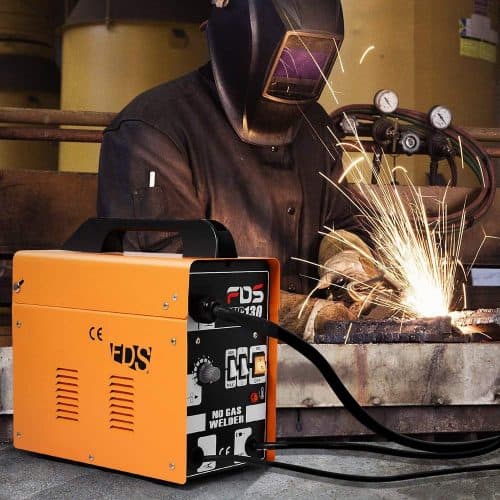What is Flux Core Welding? – [Things to Know]
Flux core welding is an automatic or semi-automatic fusion welding process, and it was introduced in the early 1950s, as an alternative to shield metal arc welding.
In practice, it’s similar to MIG welding, in which both of these processes use a continuously-fed consumable tubular electrode.
A striking difference between these two processes is the flux wire. Flux core arc welding uses a hollowed-out filler wire and filled with flux. Rather than using for shielding gas from protecting the weld, flux shields the weld pool.

Table of Contents
Types of Flux Cored Welding Processes
Generally, there're two types of flux-cored welding processes, and they include; gas-shielded and self-shielded.
Each of these processes is unique in its ways and has several advantages over the other.
However, they've plenty of common grounds as both of them comprise an outer sheath and are filled with flux, which helps to protect the weld from contaminants.
Another similarity between these two processes is that they’re both gas-shielded and usually generate a slag that protects the liquid metal during cooling. However, it’s necessary to remove this slag after welding and between passes.
Gas Shielded Welding
Gas shielding requires the use of external shielding gas supply to protect the weld. Typically, using this method requires the use of a barrier to protect the weld pool, so that the shield gas is not blown away.
Gas shielding is the most popular method because it comes with a higher operator appeal, and this means it’s far easier to control, and above all, it produces aesthetically pleasing welds.
Gas shielding processes are suitable for applications such as general fabrication, pressure vessels, heavy-equipment manufacturing, or petrochemical piping.
Self-Shielding Welding
Self –shielding process, on the other hand, does not require external shielding gas supply to protect the weld.
Rather, it generates the shielding gas required for protecting the weld, and this eliminates the need for an external gas cylinder, consequently making the process highly portable and ideal for use in the remote applications.
In most cases, this process is suitable for welding applications such as bridge construction, shop fabrication, maintenance, and shipbuilding where gas cylinders and gas shielding cannot readily be used.
However, unlike the gas shielding, this process tends to produce higher levels of smoke and spatter.
How Thick Can You Weld With Flux Core?
The flux-core welding process is recommended for materials with a gauge as thin as 20 gauge, a bit thinner than the 24 gauge for MIG welding.
In general, Flux-core welding is a suitable choice for welding the thick materials, especially if you don’t want to pass through an area severally.
A 155 V flux-cored machine using an electrode of 0.35, for instance, will generally allow you to weld steel up to ¼” thick, which is more than double the thickness you would get with the same metrics (Voltage and wire diameter) on MIG welding.
For professional flux core welders using a proper machine, such as 0.45” wire feed and 230V of input power, this process can allow you to weld steel with a thickness of up to ½”.
Application of Flux Core Welding
Flux core welding is a highly versatile and multi-purpose welding process that is suited for varying applications.
In the section below, we shall look at some of the more ideal flux core welding applications that this process excels at.
Welding Dirty and Rusted Metals
Flux core welding is more rugged and one of the welding processes that do not require a clean joint.
Unlike other welding processes such as MIG, Stick, or TIG, flux core welding can burn just about anything, including rust and mill scale, but with the exception of paint, water and oils.
Flux core welding is so good at working through mill scale and rust that a single pass of this welding electrode can weld up to ½" plate with groove joint and, at the same time, achieve full penetration on both joints.
What professionals like most about this process are that it runs hot and fast in all positions, and this makes it quite an ideal option for both the shipyard and well as industrial applications.
Welding Outdoors and for Hobbyists
Unlike MG welding, flux core welding does not cause any trouble when welding outdoors.
For hobbyists, Flux core welding is an incredible option since its more forgiving and can be used for general repairs around the home or farm.
Flux core welding is known to give users more flexibility but with less equipment,
Low Skill Level Required
Unlike a majority of the welding processes, flux core welding is not skill-intensive and has no learning curve.
In more than one way, it's similar to MIG welding, and beginners find it quite easy to learn welding through this process.
The only catch of this process is that you need to know how to set up the welder properly.
Once you've over and above this stumbling block, it's only a matter of "point and shoots" operation with little welding skills required.
Conclusion
However, like any other welding process, understand that flux-core welding comes with a fair share of welding risks.
And so, before you commence any welding procedure, you must have the proper safety equipment.
This includes wearing the safety garment such as safety glasses, auto-darkening helmets, welding gloves, welding apron, and boots.

![What is Flux Core Welding? – [Things to Know] What is Flux Core Welding](https://powertoolsgeek.com/wp-content/uploads/2019/12/What-is-Flux-Core-Welding.jpg)